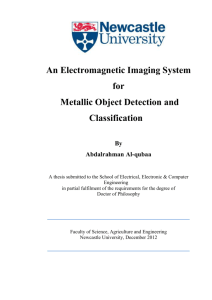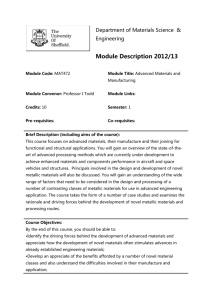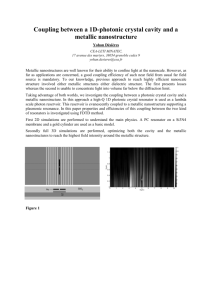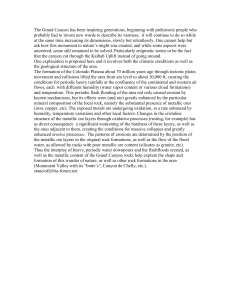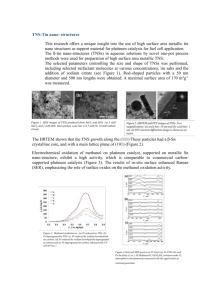ANALYTICAL MODEL OF A METASURFACE CONSIST
advertisement
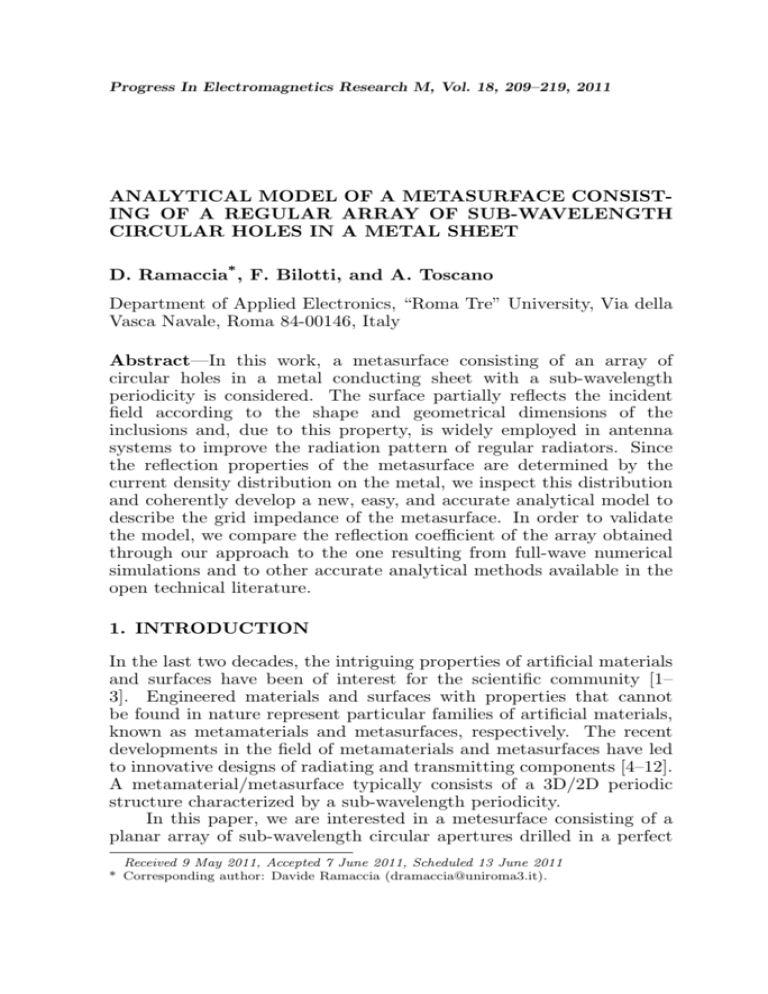
Progress In Electromagnetics Research M, Vol. 18, 209–219, 2011 ANALYTICAL MODEL OF A METASURFACE CONSISTING OF A REGULAR ARRAY OF SUB-WAVELENGTH CIRCULAR HOLES IN A METAL SHEET D. Ramaccia* , F. Bilotti, and A. Toscano Department of Applied Electronics, “Roma Tre” University, Via della Vasca Navale, Roma 84-00146, Italy Abstract—In this work, a metasurface consisting of an array of circular holes in a metal conducting sheet with a sub-wavelength periodicity is considered. The surface partially reflects the incident field according to the shape and geometrical dimensions of the inclusions and, due to this property, is widely employed in antenna systems to improve the radiation pattern of regular radiators. Since the reflection properties of the metasurface are determined by the current density distribution on the metal, we inspect this distribution and coherently develop a new, easy, and accurate analytical model to describe the grid impedance of the metasurface. In order to validate the model, we compare the reflection coefficient of the array obtained through our approach to the one resulting from full-wave numerical simulations and to other accurate analytical methods available in the open technical literature. 1. INTRODUCTION In the last two decades, the intriguing properties of artificial materials and surfaces have been of interest for the scientific community [1– 3]. Engineered materials and surfaces with properties that cannot be found in nature represent particular families of artificial materials, known as metamaterials and metasurfaces, respectively. The recent developments in the field of metamaterials and metasurfaces have led to innovative designs of radiating and transmitting components [4–12]. A metamaterial/metasurface typically consists of a 3D/2D periodic structure characterized by a sub-wavelength periodicity. In this paper, we are interested in a metesurface consisting of a planar array of sub-wavelength circular apertures drilled in a perfect Received 9 May 2011, Accepted 7 June 2011, Scheduled 13 June 2011 * Corresponding author: Davide Ramaccia (dramaccia@uniroma3.it). 210 Ramaccia, Bilotti, and Toscano conducting metallic sheet. Possible applications of such structures include artificial dielectrics, antenna radomes, frequency selective surfaces, etc.. Particularly, their use is highly desired in antenna applications, allowing to: a) enhance the directivity of the radiators, increasing their effective radiating area; b) reduce the back-radiation and the wind resistance when used as reflectors. Interesting examples of applications to enhance the antenna directivity are reported in [13– 15]. Being the dimensions of the array elements much smaller compared to the operating wavelength, an effective boundary condition can be used to describe the electromagnetic behavior of the metasurface. By defining an average value of the tangential electric field and of the surface current density on the array plane, in fact, it is possible to introduce an effective grid impedance Zg describing the electrical properties of the structure [16–20]. Exciting the metasurface through an impinging plane-wave and inspecting the surface current density distribution on the metallic region between two adjacent circular apertures, we observe varies variation along the direction of the incident electric field. Since the operating wavelength is assumed much larger than the periodicity, a quasi-static approach can be used to describe the electromagnetic behavior of the structure and the current density distribution should depend only on the geometrical parameters of the metallic regions. Considering a square lattice for the aperture arrangement, the structure can be seen as a grid of metal strips with non-constant width where the surface current flows. Using this approach, the analytical formulas already developed for the grid impedance of a grid of metallic strips with constant width [21] can be properly modified in order to accurately describe the behavior of the considered structure. The new proposed model is verified comparing the obtained reflection coefficient to the one resulting from full-wave numerical simulations based on the employment of CST Studio Suite [22]. According to [23], we have simulated just one unit-cell using proper boundary conditions. As a further reference, we consider also the results given by other accurate analytical models available in the open technical literature and based on the polarizability of the inclusions [16]. The structure of the paper is as follows. In Section 1, we briefly introduce the approach to the problem and present the analytical method used to evaluate the effective width of the equivalent grid of metal strips. In Section 2, we compare the amplitude of the reflection coefficients for TE and TM polarizations obtained through our model, other models, and full-wave results. In Section 4, we Progress In Electromagnetics Research M, Vol. 18, 2011 211 draw the conclusions and highlight, under the validity limitations, the advantages of our proposed approach. 2. ANALYTICAL MODEL When a plane-wave impinges on a metallic surface, the tangential components of the electric and magnetic fields excite an uniform surface current density. The electric field reflected by the surface experiences a 180◦ phase-shift, due to the reaction of the surface. Under the same illumination conditions, the surface current density (a) (b) (c) Figure 1. Representation of the surface current and concatenated magnetic field for an array of (a) circular holes in a metallic sheet and (b) metallic strips; (c) map of the magnitude of the surface current for k0 S = 0.5 and R = 0.45S. 212 Ramaccia, Bilotti, and Toscano on a metasurface consisting of an array of sub-wavelength circular apertures is not uniform, but rather shows high values in the metallic regions with minimum width between two adjacent holes (Figure 1). Investigating the distribution of the surface current density, we observe that its maximum value is in correspondence of the minimum width of the metallic region between two holes and it decreases moving away from this point (Figure 1(c)). Since the operating wavelength is much larger than the periodicity of the structure, the unit-cell is assumed as excited by a quasi-static electromagnetic field. In this case, the current density distribution should depend only on the width of the metallic region in x-direction (see Figure 1(a)). On the contrary, on metasurface consisting of squared apertures the surface current density is quite constant on the metallic strips between two adjacent squared holes (see Figure 1(b)). Starting from this approach, we apply the integral mean value theorem over the metallic region between two circular holes, evaluating an effective width weff in order to model it as an equivalent array of sub-wavelength squared holes. In Figure 2 a zoom on the metallic region between two adjacent circular patches is shown. The integrating area A is vertically defined by the angle ϕ and horizontally delimited by the edges of the holes. The area A can be expressed in terms of the radius R of the holes, and the height y0 as follows: " Ã ! # q 1 y S 0 R2 tan−1 p + y0 R2 − y02 (1) A = y0 − 2 2 R2 − y02 where y0 = R sin ϕ. Dividing the area A by y0 , an average value of the width of the metallic region between the two holes as a function of the Figure 2. Integrating region between two adjacent holes. Progress In Electromagnetics Research M, Vol. 18, 2011 (a) Figure 3. polarization. Oblique incidence: 213 (b) (a) TE polarization; (b) TM angle ϕ can be found as: µ weff (ϕ) = S − R cos ϕ − ϕ sin ϕ ¶ (2) According to the polarization and to the angle of incidence of the incoming wave, the area of the metallic region involved in the flow of the current changes and consequently the effective width of the equivalent strips too. The height y0 , that is directly related to the angle ϕ, defines the extension of the area A. In order to evaluate a constant value of the effective width weff , we define the values of the angle ϕ for TE and TM polarization (Figure 3). For TE polarization, the electric field is parallel to the array plane whatever the angle of incidence θ is as shown in Figure 3(a). In this case, the metallic region involved in the flow of the current density is maximum and defined by the angle: π ϕTE = (3) 2 For TM polarization, the tangential component of the incident electric field is Et = E0 cos θ (Figure 3(b)) and, consequently, the intensity of the surface current density decreases with the angle of incidence. The metallic region A (Figure 2), thus, should decrease as function of the incident angle θ, accordingly. In this case, the metallic region involved in the flow of the current varies with the angle of incidence and is defined by the angle: π ϕTM = cos2 θ (4) 2 where the quadratic dependence is justified by the fact that the angle ϕ defines the coordinate y0 that in the circumference equation appears in a quadratic form. 214 Ramaccia, Bilotti, and Toscano Inserting Equations (3)–(4) into (2), we obtain the constant effective width of an equivalent array of metallic strips for both polarizations. It now can be used in the readily available analytical formulas of the grid impedance of an array of metal strips [17, 18, 21] and we obtain the grid impedance of an array of circular holes in a metal sheet: " Ã !# TE πw k S eff 0 ZgTE = jZ0 ln sin−1 (5) holes 2π 2S " Ã !# µ ¶ TM πw k S sin2 θ eff 0 TM −1 Zgholes = jZ0 ln sin 1− (6) 2π 2S 2 √ where Z0 and k0 = ω ε0 µ0 are the wave impedance and the wave vector in vacuum, respectively, and S is the periodicity of the array. TE and w TM are constant values evaluated using The effective widths weff eff Equation (2) when the ϕ is ϕTE and ϕTM , respectively. The validity of Equations (5)–(6) is guaranteed when the periodicity S of the structure is sub-wavelength and the effective width of the strips is much smaller than the periodicity [17, 18, 21]. In order to keep the validity of the formulas after the introduced modifications, the dimensions of the holes should be comparable to the periodicity of the array. 3. VALIDATION OF THE MODEL The electromagnetic properties of the grid array can be expressed in terms of the transmission and reflection coefficients. If the metallic array is printed on a dielectric substrate, it is possible to define an effective permittivity of the surrounding host medium as described in [24]. Using a transmission line model, the shunt reactive impedance Zg modeling the array is connected to two infinitely extended transmission lines of impedance Z` , as show in Figure 4. If the host medium is the free-space,pthe characteristic impedance Z` of the transmission lines is Z0 = µ0 /ε0 . In case of oblique Figure 4. Transmission-line model of a dense array in a uniform host medium. Progress In Electromagnetics Research M, Vol. 18, 2011 215 incidence, as show in Figure 3, the free-space impedances are given by: Z0 cos θ = Z0 cos θ Z0TE = Z0TM (7) and the reflection coefficients are: ΓTE = − Z0TE ; Z0TE + 2ZgTE ΓTM = − Z0TM Z0TM + 2ZgTM (8) In Figures 5, 6, and 7 the amplitude of the reflection coefficient versus the normalized period k0 S for different angles of incidence and both polarizations is shown. The radius R of the holes is set to R = 0.45S. The solid lines represent the amplitude of the reflection coefficient of the array of circular holes in a metallic sheet modeled using the proposed method based on the effective width of the metallic strips. The hollow circles represent the results obtained through the full-wave numerical simulator CST Studio Suite [21]. The two sets of results agree reasonably well in all the reported cases. For a further validation, we compare our model to the one presented in [16] for a complementary structure, i.e., an array of disks, after a proper application of Babinet’s principle (dot-line). The agreement between the proposed model, based on the effective width, and the two references, i.e., the numerical simulations and the polarizability-based model, is rather good, showing the validity of the proposed approach. Figure 5. Reflection coefficient vs. normalized periodicity at normal incidence for both polarizations. 216 Ramaccia, Bilotti, and Toscano Figure 6. Reflection coefficient vs. normalized periodicity at oblique incidence (θ = 20◦ ) for both polarizations. Figure 7. Reflection coefficient vs. normalized periodicity at oblique incidence (θ = 40◦ ) for both polarizations. 4. CONCLUSIONS In this paper, a new analytical model for a partially reflective metasurface consisting of an array of circular holes in an ideally conducting sheet has been presented. Investigating the distribution of surface current density, we defined an effective width of the metallic region between two adjacent circular holes. The effective width has been inserted in the simple and compact formulas of the grid impedance of an array of metallic strips. After the reported successful comparison of the results obtained using this approach to the full-wave numerical simulations and other analytical results obtained using more involved and complex methods based on the derivation of the polarizability of the unit-cell, we can conclude that the new model we have developed can be straightforwardly employed for the accurate and fast design of Progress In Electromagnetics Research M, Vol. 18, 2011 217 metasurfaces, consisting of arrays of circular apertures in a metallic sheet. The proposed model has been shown to be robust for both polarizations and different angles of incidence. Before concluding, we remark that the potential of the proposed model resides in the ability to be applied to more complex unit-cell shapes, such as ellipses, rounded bowties and rectangles with high axial ratio, etc.. Using the same set of the equations for the grid impedance of regular metallic strips, in fact, the effective width can be straightforwardly evaluated for the different unit-cells, leading to an easy, fast, and accurate design of different metasurfaces. It is worth mentioning also that the methods based on the polarizability of the unit-cell particle, though accurate, need the evaluation of special functions, as reported for the circular case in [16], and, thus, are not readily applicable for a fast design, as our proposed method does. REFERENCES 1. Bilotti, F., A. Toscano, and L. Vegni, “FEM-BEM formulation for the analysis of cavity backed patch antennas on chiral substrates,” IEEE Trans. Antennas Propagat., Vol. 51, 306–311, 2003. 2. Bilotti, F., L. Vegni, and A. Toscano, “Radiation and scattering features of patch antennas with bianisotropic substrates,” IEEE Trans. Antennas Propagat., Vol. 51, 449–456, 2003. 3. Scamarcio, G., F. Bilotti, A. Toscano, and L. Vegni, “Broad band U-slot patch antenna loaded by chiral material,” Journal of Electromagnetic Waves and Applications, Vol. 15, No. 10, 1303– 1317, 2001. 4. Bilotti, F., A. Alù, N. Engheta, and L. Vegni, “Anomalous properties of scattering from cavities partially loaded with double-negative or single-negative metamaterials,” Progress In Electromagnetics Research, Vol. 51, 49–63, 2005. 5. Bilotti, F., L. Nucci, and L. Vegni, “An SRR based microwave absorber,” Microw. Opt. Technol. Lett., Vol. 48, 2171–2175, 2006. 6. Bilotti, F., A. Toscano, L. Vegni, K. B. Alici, K. Aydin, and E. Ozbay, “Equivalent circuit models for the design of metamaterials based on artificial magnetic inclusions,” IEEE Trans. Microw. Theory Tech., Vol. 55, 2865–2873, 2007. 7. Alù, A., F. Bilotti, N. Engheta, and L. Vegni, “Sub-wavelength planar leaky-wave components with metamaterial bilayers,” IEEE Trans. Antennas Propagat., Vol. 55, 882–891, 2007. 8. Bilotti, F., S. Tricarico, and L. Vegni, “Electromagnetic cloaking 218 9. 10. 11. 12. 13. 14. 15. 16. 17. 18. 19. 20. 21. Ramaccia, Bilotti, and Toscano devices for TE and TM polarizations,” New J. Phys., Vol. 10, 115035, 2008. Bilotti, F., A. Alù, and L. Vegni, “Design of miniaturized metamaterial patch antennas with µ-negative loading,” IEEE Trans. Antennas Propagat., Vol. 56, 1640–1647, 2008. Bilotti, F., A. Toscano, K. B. Alici, E. Ozbay, and L. Vegni, “Design of miniaturized narrowband absorbers based on resonant magnetic inclusions,” IEEE Trans. Electromag. Comp., Vol. 53, 63–72, Feb. 2011. Tretyakov, S. A., S. I. Maslovski, and P. A. Belov, “An analytical model of metamaterials based on loaded wire dipoles,” IEEE Trans. Antennas Propagat., Vol. 51, 2652–2658, 2003. Belov, P. A. and C. R. Simovski, “Subwavelength metallic waveguides loaded by uniaxial resonant scatterers,” Phys. Rev. E, Vol. 72, 036618, 2005. Guèrin, N., S. Enoch, G. Tayeb, P. Sabouroux, P. Vincent, and H. Legay, “A metallic Fabry-Perot directive antenna,” IEEE Trans. Antennas Propagat., Vol. 54, 220–224, 2006. Kumar, A. and H. D. Hristov, Microwave Cavity Antennas, Artech House, New York, 1989. Yang, F. and Y. Rahmat-Samii, Electromagnetic Band Gap Structures in Antenna Engineering, Cambridge University Press, 2008. Viitanen, A. J., I. Hänninen, and S. A. Tretyakov, “Analytical model for regular dense arrays of planar dipole scatterers,” Progress In Electromagnetics Research, Vol. 38, 97–110, 2002. Tretyakov, S., Analytical Modeling in Applied Electromagnetic, Artech House, Boston, 2003. Yatsenko, V. V., S. A. Tretyakov, S. I. Maslovski, and A. A. Sochava, “Higher order impedance boundary conditions for sparse wire grids,” IEEE Trans. Antennas Propagat., Vol. 48, No. 5, 720–727, 2000. Yatsenko, V., S. Maslovski, and S. Tretyakov, “Electromagnetic interaction of parallel arrays of dipole scatterers,” Progress In Electromagnetics Research, Vol. 25, 285–307, 2000. Tretyakov, S. A. and A. Viitanen, “Line of periodically arranged passive dipole scatterers,” Electrical Engineering, Vol. 82, 353– 361, 2000. Luukkonen, O., C. R. Simovsky, G. Granet, G. Goussetis, D. Lioubtchenko, A. Raisanen, and S. Tretyakov, “Simple and accurate analytical model of planar grids and high-impedance Progress In Electromagnetics Research M, Vol. 18, 2011 219 surfaces comprising metal strips,” IEEE Trans. Antennas Propagat., Vol. 56, 1624–1632, 2008. 22. CST Studio Suite 2010, Computer Simulation Technology, http://www.cst.com. 23. Marcuvitz, N., Waveguide Handbook, McGraw-Hill Book Company, 1951. 24. Compton, R. C., L. B. Whitbourn, and R. C. McPherdan, “Strip gratings at a dielectric interface and application of Babinet’s principle,” Appl. Opt., Vol. 23, 3236–3242, 1984.
